- Remove From My Forums
-
Question
-
Hello everybody,
Our current environment details as following:
SCCM Version 1702
Console Version: 5.00.8498.1711
Site Version: 5.0.8498.1000
Configuration Manager 1702 Hotfix Rollup (KB4019926)
ADK Version 10.1.14393.0
am getting the above error when trying to OSD any computer.
snapshot from smsts.log
before getting this error a new device will be created. the device name is Unknown.
Tried to search if there is any duplicate mac or GUID with no luck.
I appreciate if any one can help me to fix this issue.
Best Regards
SCCM Updates
-
Edited by
Thursday, June 8, 2017 10:54 AM
-
Edited by
Answers
-
I have solved the problem by following
NeilRawlinson answer.Quote
«To recreate them, change the registry value of CreatedUnknownDDR under SOFTWAREMicrosoftSMSCOMPONENTSSMS_DISCOVERY_DATA_MANAGER on your primary site server. Set the value to 0.
Then, re-start the SMS_EXECUTIVE service. When the Discovery Data Manager (DDM) component starts, it will think that the Unknown System records have not been created, and will recreate them.
Once they had been recreated, all I had to do was disable PXE on the DP, wait a while (I waited until I got no response from TFTP (PXE-E32 error), and then re-enable PXE with unknown computer support.»
End of Quote.
snapshot from smspxe before following the above:
snapshot from smspxe after following the above:
Regards
SCCM Updates
-
Marked as answer by
OsamaAlaydi
Sunday, June 11, 2017 9:06 AM -
Edited by
OsamaAlaydi
Sunday, June 11, 2017 9:08 AM
-
Marked as answer by
Let’s check how to fix SCCM Failed To Run Task Sequence. The task sequence prompt There are no task sequences available for this computer when you start the operating system deployment with Configuration Manager during pxe boot.
This usually happens when the target machines had a task sequence deployed and had duplicate MAC addresses exist in SCCM DB. The known machine added to the deployed sccm collection is not updated.
However, you could easily see the error message from the task sequence prompt. It’s always recommended to examine the SMSTS log for task sequence failure issues to help you get the inside about the failure prompt.
Issue Summary
The task sequence deployed to All Unknown Computers for PXE boot, and the task sequence is not listed after deployment. This error appears at the initial stage when you have started the deployment. Task Sequence fails with the following error message –
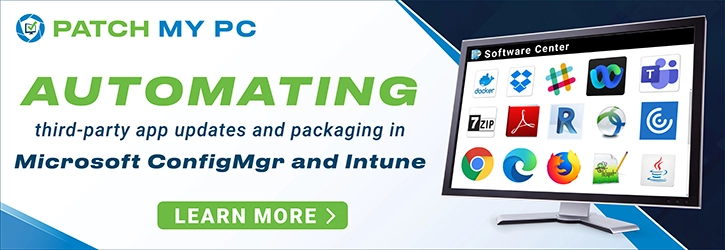
Failed to Run Task Sequence: There are no task sequences available for this computer.

In this scenario, Task Sequence terminated at the beginning. You will collect the logs at WinPE X:Windowstempsmstslogsmsts.log. To get the command prompt window, you have to press the F8 key and locate the location to Open the log. Reviewing the SMSTS.log on the site server, you will get the highlight –
There are no task sequences available to this computer.Please Ensure you have at least one task sequence advertised to this computer. Unspecified error (error: 80004005; Source: Windows)Example for Duplicate MAC having different hostname, shared by Deepak –

Let’s check the possible solution to fix if there are no task sequences available for this computer –

#Possible Solution 1 –
If you have imported the computer to the known collection using MAC ID, Ensure the device is populated to sccm device collections. You can manually update the collection membership as follows –
In the Configuration Manager console, go to the Assets and Compliance workspace. Select Device Collections, select the collection to manage and then select an Update membership.
Evaluates the membership for the selected collection. For collections with many members, this update might take some time to finish. Use the Refresh action to update the display with the new collections members after the update is completed.
#Possible Solution 2 –
Duplicate MAC Exists in SCCM DB – Removing duplicate MAC from SCCM helps you to perform the clean PXE booting. More Learn How to ConfigMgr SCCM Merge Obsolete Duplicate Records.
#Possible Solution 3 –
If you found there’s no duplicate MAC exists, the next step is to remove the device information from SCCM. Import the computer Information using MAC, GUID.
- Launch SCCM Console, Navigate to Assets and Compliance > Devices.
- Look for the device, Before removing the device entry from the SCCM Console. Collect SMBIOS GUID for the device.
Note – Collect the SMBIOS GUID for a device under the Summary tab in SCCM Console. To get SMBIOS GUID in a machine, Open the command prompt, run the command: wmic csproduct get uuid
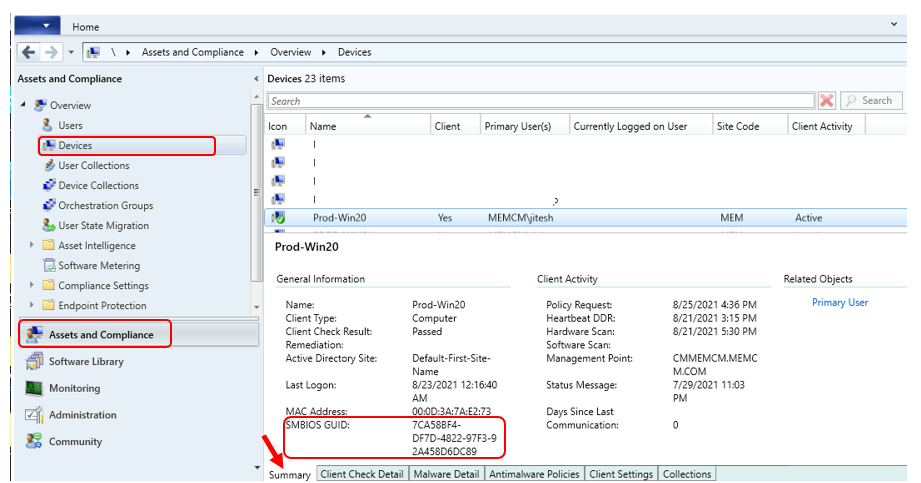
You should add a newly imported computer to a collection. This allows you to create advertisements for deploying operating systems to the computer immediately.
Once you are done with the above steps, Please wait to advertise the computer information. Restart the target machine and reinitiate the task sequence deployment. It should continue without any errors. You may not encounter messages “There are no task sequences available for this computer.”
#Possible Solution 4 –
If you’re deploying an OSD Task Sequence, In the scheduling tab, If you are leaving the option default. The deployment will be active at the current time. You might encounter an issue while performing the deployment as SCCM will skip the Task sequence that is not active yet. To resolve this issue, It’s best to have the deployment schedule configured at least a few hours before.

To change the schedule of deployed task sequence –
- In the Configuration Manager console, go to the Software Library workspace, expand Operating Systems, and select Task Sequences.
- Select Deployment tab. Right-click on the existing deployment and select Properties. Switch to the Scheduling tab. Under Schedule when this deployment will become available, chnage the time—Click Apply, and OK.

Let us know your experience with the issue and steps taken to resolve it in Comment Section.
About Author -> Jitesh has over 5 years of working experience in the IT Industry. He writes and shares his experiences related to Microsoft device management technologies and IT Infrastructure management. His primary focus area is Windows 10 Deployment solution with Configuration Manager, Microsoft Deployment Toolkit (MDT), and Microsoft Intune.
Resources
- SCCM OSD Task Sequence Troubleshooting Steps by Step Ultimate Guide SMSTS.log.
- SCCM OSD SMSTS Log File Reading Tips | ConfigMgr | MEMCM
- SCCM Logs Files | 5 Log File Reading Tips | ConfigMgr
- HTMD Blog #2 SCCM Archieve
- Remove From My Forums
-
Question
-
Hello everybody,
Our current environment details as following:
SCCM Version 1702
Console Version: 5.00.8498.1711
Site Version: 5.0.8498.1000
Configuration Manager 1702 Hotfix Rollup (KB4019926)
ADK Version 10.1.14393.0
am getting the above error when trying to OSD any computer.
snapshot from smsts.log
before getting this error a new device will be created. the device name is Unknown.
Tried to search if there is any duplicate mac or GUID with no luck.
I appreciate if any one can help me to fix this issue.
Best Regards
SCCM Updates
- Edited by
Thursday, June 8, 2017 10:54 AM
- Edited by
Answers
-
I have solved the problem by following
NeilRawlinson answer.Quote
«To recreate them, change the registry value of CreatedUnknownDDR under SOFTWAREMicrosoftSMSCOMPONENTSSMS_DISCOVERY_DATA_MANAGER on your primary site server. Set the value to 0.
Then, re-start the SMS_EXECUTIVE service. When the Discovery Data Manager (DDM) component starts, it will think that the Unknown System records have not been created, and will recreate them.
Once they had been recreated, all I had to do was disable PXE on the DP, wait a while (I waited until I got no response from TFTP (PXE-E32 error), and then re-enable PXE with unknown computer support.»
End of Quote.
snapshot from smspxe before following the above:
snapshot from smspxe after following the above:
Regards
SCCM Updates
- Marked as answer by
OsamaAlaydi
Sunday, June 11, 2017 9:06 AM - Edited by
OsamaAlaydi
Sunday, June 11, 2017 9:08 AM
- Marked as answer by
- Status
- Not open for further replies.
-
#1
Before last week, I was able to deploy operating systems without any problems. Now, it’s not possible to deploy operating systems anymore…
Error in smstslog:
There are no task sequences available to this computer.. Please Ensure you have at least one task sequence advertised to this computer. Unspecified error (error: 80004005; Source: Windows)
![]()
-
#2
Check if the TS is seen in SCCM and distribute the TS to DP once.
-
Thread Starter
-
#3
The TS is seen in SCCM and I’ve distributed the TS to DP…
-
Thread Starter
-
#4
![]()
-
#5
Glad to know that your issue is resolved. I am marking this thread as Solved.
- Status
- Not open for further replies.
- Remove From My Forums

Failed to run task sequence — There are no task sequences available for this computer
-
Question
-
I have several tasks that work, however if I create a new task or copy a working task then i get Failed to run task sequence — There are no task sequences for this computer.
Using the same laptop with the same USB media I disable the new or copied task and then enable the original task and the computer images.
This is not a BIOS time issue. This is not a USB media issue. This is not a duplicate GUID / computer device name issue.
SCCM does not like the new or copied task sequence. I have read countless articles and I have found no one with the same issue.
Thank you,
Kent Smith
- Remove From My Forums

Failed to run task sequence — There are no task sequences available for this computer
-
Question
-
I have several tasks that work, however if I create a new task or copy a working task then i get Failed to run task sequence — There are no task sequences for this computer.
Using the same laptop with the same USB media I disable the new or copied task and then enable the original task and the computer images.
This is not a BIOS time issue. This is not a USB media issue. This is not a duplicate GUID / computer device name issue.
SCCM does not like the new or copied task sequence. I have read countless articles and I have found no one with the same issue.
Thank you,
Kent Smith
Unfortunately, changing the time of deployment available back to yesterday did not help.
I did find that when I attempt to «Update Distribution Points» for the two older Boot Images that I used to create the Capture Media for Windows 10 (vs 10.0.10240.16384) completed with errors when running Update Distribution Points. Do you suggest that I remove these Boot Images? Here are the errors it reported (happened with both x86 and x64):
Error: Boot image to update:
· Microsoft Windows PE (x86)
Error: Actions to perform:
· Add ConfigMgr binaries
· Set scratch space
· Enable Windows PE command line support
Error: Failed to import the following drivers:
Optional components:
· Scripting (WinPE-Scripting)
· Startup (WinPE-SecureStartup)
· Network (WinPE-WDS-Tools)
· Scripting (WinPE-WMI)
Error: The wizard detected the following problems when updating the boot image.
· Failed to install required components into the boot image
The SMS Provider reported an error.: ConfigMgr Error Object:
instance of SMS_ExtendedStatus
{
· Description = «Failed to inject OSD binaries into mounted WIM file (often happens if unsigned drivers are inserted into x64 boot image)»;
· ErrorCode = 2152205056;
· File = «e:nts_sccm_releasesmssiteserversdk_providersmsprovsspbootimagepackage.cpp»;
· Line = 4970;
· ObjectInfo = «CSspBootImagePackage::PreRefreshPkgSrcHook»;
· Operation = «ExecMethod»;
· ParameterInfo = «SMS_BootImagePackage.PackageID=»GIS0010F»»;
· ProviderName = «WinMgmt»;
· StatusCode = 2147749889;
};
I don’t believe I have any drivers in my Boot Images. I don’t believe I ever have. Should I?
SCCM
May 7, 2011May 26, 2011
1 Minute
I was trying OS deployment on a server multiple times, it refused find assigned task sequences. I double checked target server’s SMBIOS id and MAC address in assigned server. It keep failing with this error:
There are no task sequences available for this computer.
If you look in the SMSTS.log you may also see the following error:
No assigned task sequence.
Setting wizard error: There are no task sequences available for this computer.
It turned out to be there is a duplicate SMBIOS id exists in SCCM database. Of course I am trying to rebuilding a existing server…..God Dammit!!! Don’t they tell in plain English there is a duplicate BIOS id exists in the error messages. Another Microsoft error wasted my time.
I have deleted the previous server name from SCCM computer collection and retried with great success.
Reference information: OSD Task Sequence fails with «There are no task sequences available for this computer» if multiple machines have the same SMBIOS GUID
Published by —Anand—
Being in Silicon Valley for years, I became a IT Infrastructure Geek by experience and surrounded by other Geeks everywhere. I try to help others by the solutions I found on odd occasions.
View all posts by —Anand—
Published
May 7, 2011May 26, 2011
Another SCCM detective story 🙂
Usually when you see a message [There are no task sequences available for this computer] after you set the IP addresses in the OSD deployment wizard, it means that Computer association was not completed correctly and SCCM is not able to find a server record in its database to map OSD Task Sequence to it.
In my case association was correct [to make sure that it was I’ve recreated association several times].
Variables [IP address, MAC address] are in place.
Server was able to communicate with SCCM.
Site Boundaries are in place [IP ranges are configured].
So, it’s time to read the log 🙂 Boot SCCM agent and press F8. Go to X:WindowsTempSMSTSLog and run “notepad smsts.log”. Log was showing that SCCM is able to find the computer, but nothing is advertised to it.
Hm, OK. I double checked collection and computer properties. SCCM was clearly showing that there is a Task Sequence assigned to my new computer.
Lets try again. Reboot, Wizard, same error, reading the log again. And suddenly one strange record caught my eye: “Netbios Name = ServerName”, where ServerName was not the name of my server, but one of the existing servers’. WTF, I thought silently 🙂 Why SCCM thinks that this brand new server is tied to an existing old record? Association must be done based on the MAC address, which is unique.
At this point I had enough material to google it 🙂 SCCM identifies new computers by BIOS GUID and MAC, and there is a chance that two servers can have the same BIOS GUID. Well, our environment is configured to use MAC address based associations, not GUID, but that was an interesting hint.
I’ve extracted servers’ GUID:

Then made a Report in SCCM that showed me all the servers with this GUID:
select v_R_System.Name0,v_R_System.SMBIOS_GUID0 from v_R_System where v_R_System.SMBIOS_GUID0 = '4C4C4544-0000-2010-8020-80C04F202020'
Query found even 2 servers with the same GUID. All that pointed to a hardware side, DELL in this case. Obvious question – can I change the GUID? I googled it and when I saw a post with the same GUID in it I was completely convinced that this is a hardware issue. DELL server generates ‘4C4C4544-0000-2010-8020-80C04F202020’ GUID when the Service Tag/Asset Tag are not configured.
My server had Service Tag, but empty Asset Tag. Data Centre guy contacted DELL support and it appeared that there is a special utility to fix that – svctag.exe
Unique GUID was generated as soon as the Asset Tag was set:

Advertised OSD was detected and I was able to continue the build 🙂

Today we were unable to image one of our machines due to a Task Sequence error. Imaging was working fine since we upgraded to 2103 but then this error threw me off. I thought initially it was related to the new Task Sequence I created for 21H1 so I went ahead and double checked the deployment settings. All of the deployment settings looked fine. We have been having issues with our media drives lately so I thought I would try another flash drive but still got the same error.

So then I decided to check the smsts.log file to see if anything was yelling at me. At first I couldn’t find any rhyme or reason on why this was failing but after some reading, I realized that the wrong machine name was in the log file.
If you search for Netbios name, it will show you the name of the machine in question. What was showing was the previous machine that we imaged. I should mention we were imaging Microsoft Surface machines using a universal dock for ethernet. This somehow must have been cached. I’m sure moving to another port may have fixed the issue as well but I actually just updated the membership in SCCM for the device collection and that fixed the issue.
Navigate to Assets and Compliance>Overview>Device Collections and find the collection in question. Right click and select Update Membership. I did this for our Windows 10 device collection and All Unknown Computers collection as well. I waited about 10 minutes and the Task Sequence went through like normal.

I’ll need to do more research on why and how this happened but for now, this is a quick fix.
- Remove From My Forums
-
Question
-
I have tried creating a new collection and try adding MAC’s to it but the MAC’s are not found in all system collection. I have deployed to those systems before today. I have TS advertised to All Unknown computers as well as to a collection for OSD to
account for new and rebuild machines.What can i troubleshoot and where can i start looking for get pass the «there are no task sequences available for this computer»
Thank you.
-
Moved by
Tuesday, October 16, 2012 8:49 PM
(From:Configuration Manager 2007 General)
-
Moved by
Answers
-
I got the error message because the date/time setting of the machine that I tried to set up was incorrect (the creation date of the boot stick with the task sequence was newer than the date set).
-
Proposed as answer by
Garth JonesMVP
Saturday, April 8, 2017 2:39 PM -
Marked as answer by
Garth JonesMVP
Tuesday, June 20, 2017 9:26 PM
-
Proposed as answer by
First published on TECHNET on Aug 03, 2017
Starting with System Center Configuration Manager, version 1702, unknown computers that are started from media or PXE may not find task sequences targeted to them. The SMSTS.log shows:
There are no task sequences available to this computer. Please ensure you have at least one task sequence advertised to this computer»
Unspecified error (Error: 80004005; Source: Windows)
This issue may occur if the
Previous
button on the «Select a task sequence to run» page is selected on the unknown computer.
This is a known issue that is now fixed by applying
Update rollup for System Center Configuration Manager current branch, version 1702
.
In this post I will be discussing on how to fix the issue “no task sequence found” for new devices. This is a very common error we see while trying to initiate the SCCM task sequence. Sometimes we see this error for old devices and sometimes for new devices. Let’s looking into it why it is caused.
Error No task sequence found for existing devices
In a scenario where you wanted to rebuild an existing system, once the boot image is loaded either through boot media or PXE boot, you will get error:
Failed to Run Task Sequence
No task sequence found
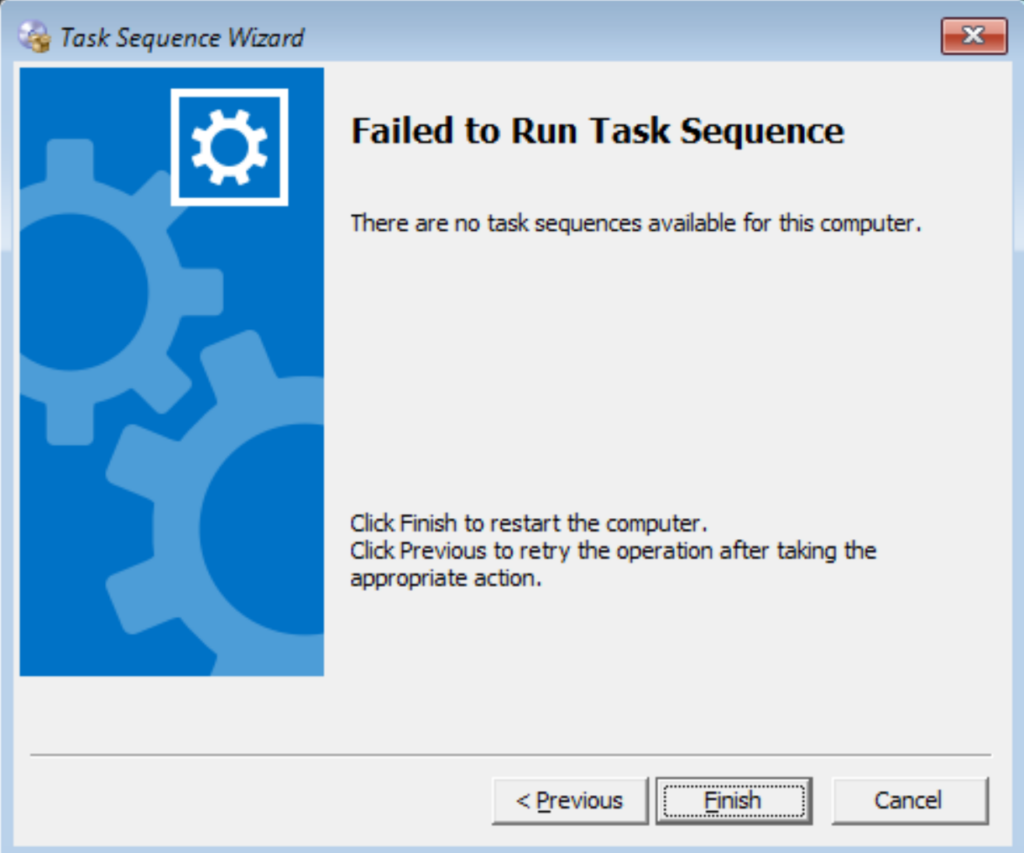
This is perfectly ok as the device is already there in SCCM database and the status is known to SCCM. Usually, task sequence is targeted to Unknown Computers, as the device already exist in SCCM database, you won’t be able to see list of task sequence targeted to All Unknown Computers collection.
To resolve the problem, delete the existing system from SCCM. If you are having trouble which device to delete, find the mac address of the device in smsts.log when you see error.
Press F8 to open command prompt, type:
Cmtrace.exe x:windowstempsmstslogsmsts.log
We can see the error in log file:
No assigned task sequence.
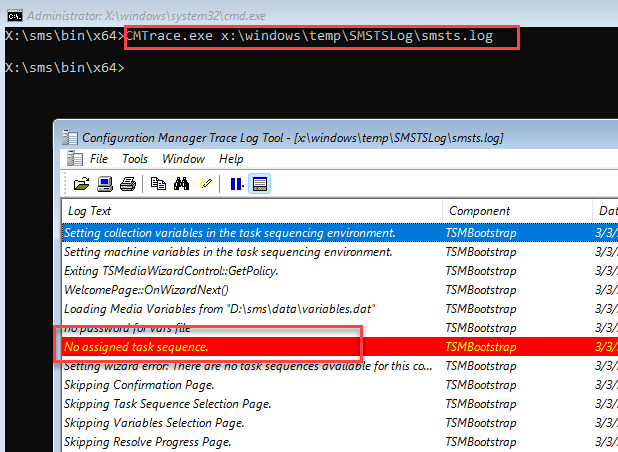
Search for phrase “Mac Address”, once found make a note of this.

Open Configuration Manager console and navigate to Assets and ComplianceOverviewDevices, enable the column “MAC address” and search for mac address we saw in smsts.log.
Simply delete the entry. Now when you try pxe boot or load boot media, you will be able to see list of task sequence.

No task sequence found for new devices
Above mentioned example was pretty much easy to understand as it was related to existing device which needs to be removed from SCCM database. But what about a brand new device which your company procured and you see the error message “No Task Sequence found”, this could be quite confusing that why we are getting this error message even though device is brand new and not in SCCM database.
Why we see error No task sequence found for new device
If you are using Dongle / Ethernet adapter which is quite common nowadays as Rj-45 connector might not be present in new devices, then the chances are – you are using the same ethernet adapter multiple times for various devices. When you use the Ethernet adapter for first time for a device, the MAC address of adapter gets registered with the device which you have built. The device will be having 2 physical mac addresses registered with SCCM, one is for inbuilt network card and another for Ethernet adapter we used.
When we use same Ethernet adapter for another device, SCCM will check the hardware identifier of the device ie. Mac address / SMBIOS GUID. As the Mac address was already registered for previous device, it will be treated as known device and you will be represented with error “No task sequence found”.
To resolve the issues temporarily, you can delete the hostname of previous device which got registered along with MAC address of ethernet adapter. But that’s not a good approach, you have to delete the entry every time whenever you are trying to build new device.
Another approach would be to add this information into SCCM so that Configuration Manager is aware of this Mac address to ignore while initiating task sequence build.
Under Configuration Manager console, navigate to AdministrationOverviewSite ConfigurationSites, click on Hierarchy Settings.
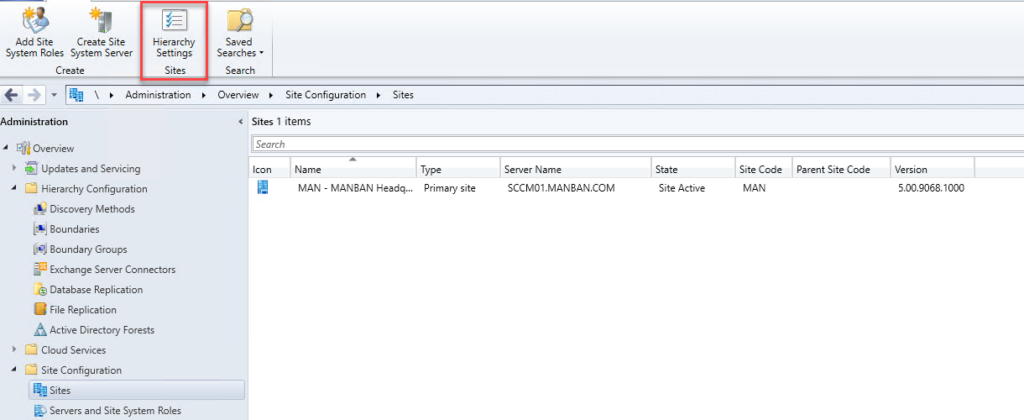
Under Hierarchy Settings Properties, click on Client Approval and Conflicting Records. Under Duplicate hardware identifiers section click on Add to open Add Duplicate Hardware ID popup and proceed with adding with Hardware ID.

Using this technique is exactly same as we used to do for older versions of Configuration manager, ie. to add MAC address under following registry:
ComputerHKEY_LOCAL_MACHINESOFTWAREMicrosoftSMSCOMPONENTSSMS_DISCOVERY_DATA_MANAGER
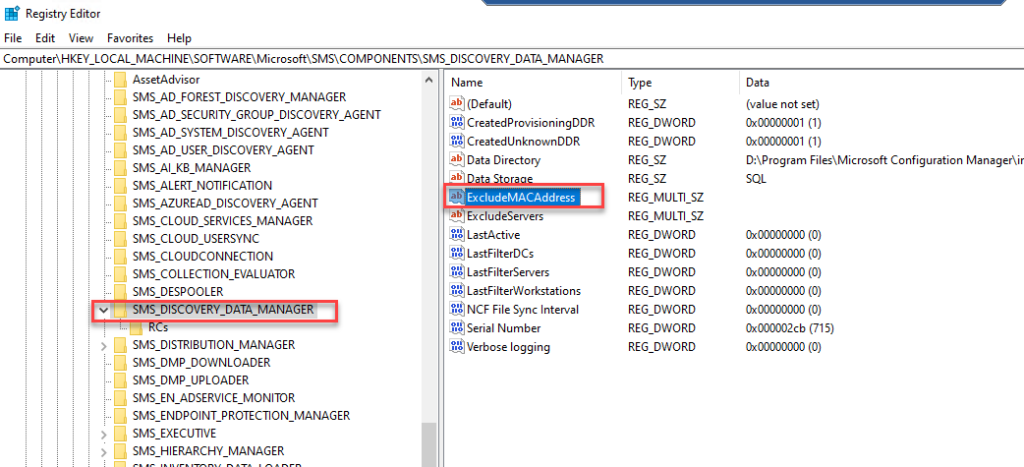
The name of the key is ExcludeMACAddress, here you can add multiple MAC address.
This would be no longer required now as we have now feature available in SCCM console itself with the name Duplicate hardware identifiers.
